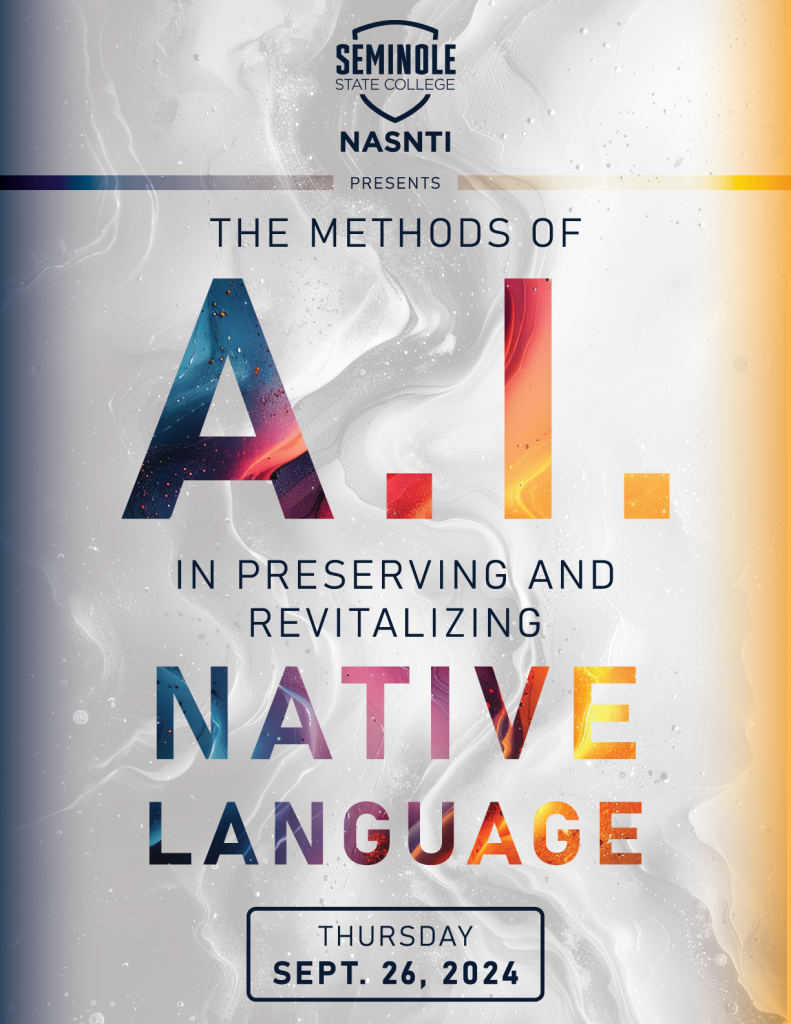Seminole State College NASNTI (Native American-Serving Nontribal Institutions) is a federally funded grant program. While SSC is a nontribal institution, Seminole State College (SSC) does have a significant Native American student population, which qualifies the college for this federal grant. Last year, SSC was also awarded a supplemental grant to support the revitalization and preservation of Native American Language. Part of the supplemental grant funds have been allocated to sponsor an Artificial Intelligence Symposium, featuring innovations in AI and its aid in preserving and revitalizing Native languages.
Event Overview
Date
September 26, 2024
Keynote
10:10 – 11:15 a.m.
Location: Jeff Johnston Fine Arts Auditorium
Breakout Sessions
Session 1: 11:30 a.m. – 12:15 p.m.
Session 2: 12:20 p.m. – 1:05 p.m.
Session 3: 1:10 p.m. – 1:55 p.m.
Location: SSC Library

Keynote Speaker
GenAI and Education

Presented by Deidre Holmberg, Principal Tech Education Strategist at Amazon Web Services
Location
Jeff Johnston Fine Arts Auditorium
Presentation Time
10:10 a.m. – 11:15 a.m.
About the Speaker
Deidre Riordan Holmberg, a technology education strategist, has become a key influencer for students and educators in the field of cloud computing. As the Principal Tech Education Strategist at Amazon Web Services (AWS), Holmberg helps shape the future of cloud technology education and empowers individuals and organizations to harness the cloud’s potential.
A sought-after speaker at national conventions, Holmberg is known for her engaging presentations on cutting-edge technologies and their practical applications. Her work has captivated audiences nationwide, sparking curiosity and deepening understanding of the rapidly evolving tech landscape.
Holmberg’s contributions to science and technology education have earned her a place in the Pacific Science Center Hall of Fame. Her dedication to promoting STEM education and empowering the next generation of innovators has left a lasting impact on communities nationwide.
Breakout Sessions
The symposium features three Breakout Session Speakers Renita DiStefano, Sean Muir, and Paula Starr. Each Breakout Session is free and will rotate three times. 30 spots are available per session. To reserve your spot, click the button below or call the NASNTI Program at 405-382-9646.
AI Strategy in Tribal Government: Preparing for the Unimaginable Future

Presented by: Paula Starr, Chief Information Officer of the Cherokee Nation
Room
119A, Boren Library
Presentation Times
- Session 1: 11:30 a.m. to 12:15 p.m.
- Session 2: 12:20 p.m. to 1:05 p.m.
- Session 3: 1:10 p.m. to 1:55 p.m.
About the Session
During this session on AI strategy at tribal nations, we will delve into the critical topic of preparing our people and systems for an AI-driven world. We will discuss the importance of developing technology strategies that can guide tribal nations into uncharted and unforeseeable futures. We will explore various approaches to ensure that tribal governments are not left behind but rather are leading the way in embracing the potential of artificial intelligence, while integrating AI into overall strategic planning and decision-making processes.
About the Speaker
Paula Starr is a Cherokee citizen leading technology delivery at the Cherokee Nation, the United States’ largest federally recognized tribe. She leads an IT department that supports 5,000 employees across the 7,000 square mile Cherokee reservation and provides service to 460,000 citizens across the United States and the globe. Paula has been recognized as one of the Top 100 Women in Technology-by-Technology Magazine and was named by Constellation Research in their list of top 150 executives leading the way for digital transformation and by HR Executive as a Top 100 HR Tech Influencer.
The Importance of Data Sovereignty and Data Governance Involving the Use of AI in Preserving and Revitalizing Native American Languages

Presented by: Renita DiStefano, President and CEO of Second Derivative
Room
120A, Boren Library
Presentation Times
- Session 1: 11:30 a.m. to 12:15 p.m.
- Session 2: 12:20 p.m. to 1:05 p.m.
- Session 3: 1:10 p.m. to 1:55 p.m.
About the Session
Tribes have the right to own and control data about their people, land, and resources. This includes decisions about who can access and use the data. Tribes establish policies and procedures for the management of their data, ensuring it aligns with their cultural values and priorities. Protecting the confidentiality and integrity of tribal data is paramount, particularly given the historical misuse and exploitation of Indigenous information. If a Tribe has not defined for themselves what Data Sovereignty means to them, or what data is considered sacred, accessible only to tribal members, can they truly be ready for leveraging AI in language preservation? Once that data is shared publicly, does a tribe really have control over that data?
About the Speaker
Renita DiStefano is the founder, President & CEO of Second Derivative, a Native woman-owned business that provides a broad complement of technology services including Cybersecurity advisory, design, engineering, and assurance services. Her career and passion for IT began over two decades ago and she worked her way tirelessly through the spectrum of IT disciplines to become the respected leader that she is today.
With 17 years dedicated to the Tribal Gaming & Hospitality industry, she is a recognized trailblazer in the industry. Renita is thought to be one of the first Native women to rise to the title of Chief Information Officer (CIO) and Chief Information Security Officer (CISO). Renita is a member of the Seneca Nation, Hawk Clan, and is regarded as one of just a handful of Native American Cybersecurity experts. She holds a Master of Business Administration (MBA) degree and has earned multiple Information Security endorsements, including the Certified Information Systems Security Professional (CISSP) – the world’s premier cybersecurity accreditation. Her other credentials include CISM, CISA, CRISC, CSOX, CGEIT, and CMMC-RP.
Preserving Language with Indigenous Content: Graphic Novels and Motion Comics

Presented by: Sean Muir, Founder and Executive Director of iStory
Room
126A Boren Library
Presentation Times
- Session 1: 11:30 a.m. to 12:15 p.m.
- Session 2: 12:20 p.m. to 1:05 p.m.
- Session 3: 1:10 p.m. to 1:55 p.m.
About the Session
In this session, Mr. Muir will dive into the world of how animation is a great retention strategy.
About the Presenter
The Indigenous Story Studio Society or iStory has published 20 books that have sold over half a million copies since 2005. iStory has been nominated for best animated short at the American Indian Film Festival three times and has been the recipient of the President’s Award from the Canadian Association for Suicide Prevention for their work around language retention and suicide literacy. The impetus behind the organization is that Sean Muir, founder and Executive Director, didn’t believe that pamphlets and brochures were adequate in teaching youth about health and social issues. He remembered reading comic books with friends as a kid, and particularly one friend who read two or three books to his one.
So, he asked the friend: how do you read so fast? The friend replied, ‘I don’t. I just look at the pictures and get the gist of what’s going on.’ Sean remembered that kid in school: when reading aloud, he had poor literacy. That gave Sean the idea to expose youth to hard-to-discuss topics using a medium that they found not only non-threatening but enjoyable.